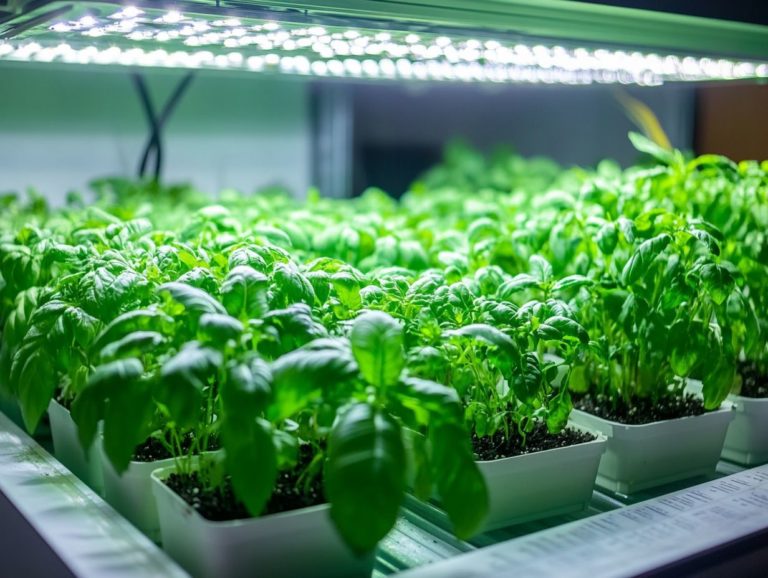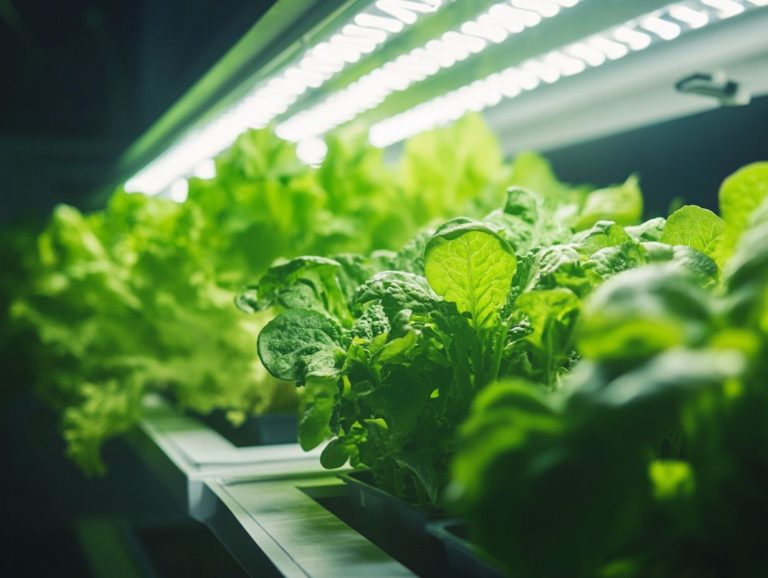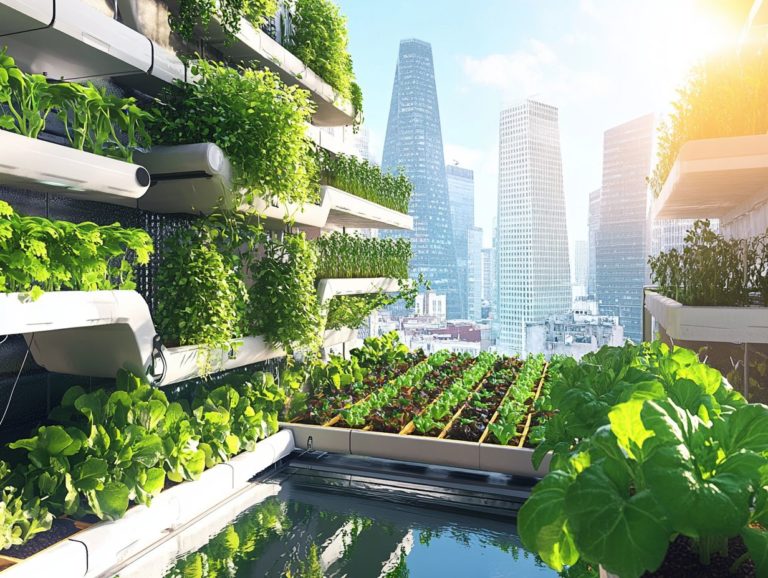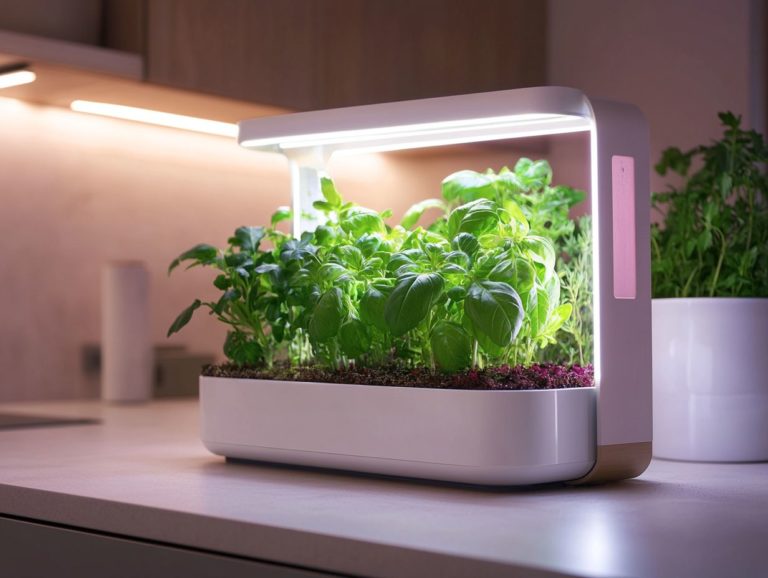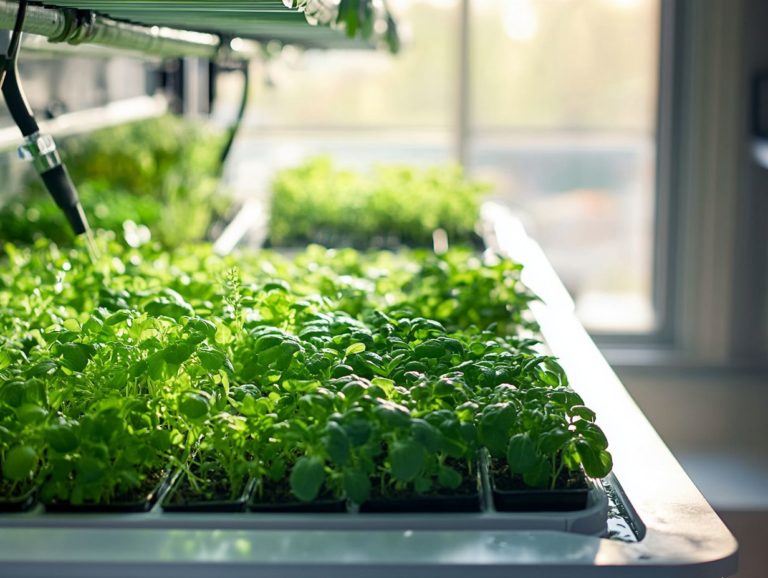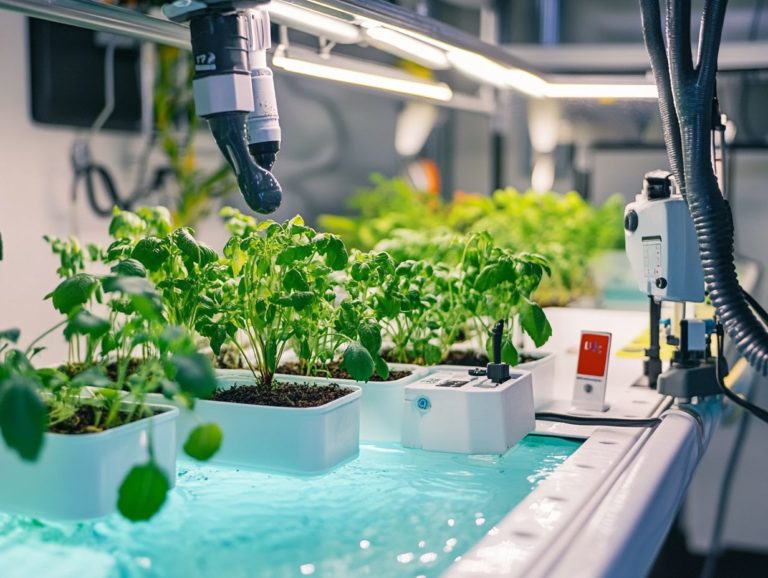Aeroponics vs. Hydroponics: Key Differences Explained
In the realm of soilless gardening, aeroponics and hydroponics stand out as two innovative methods that promise enhanced efficiency and yield.
While both techniques rely on water mixed with nutrients to cultivate plants, they employ distinct approaches that set them apart.
This article delves into the essentials of each system, illuminating their key differences and weighing the advantages and disadvantages of both methods.
Whether you re an experienced gardener or a curious novice, understanding these techniques will empower you to make informed decisions for your own gardening pursuits.
Contents
- Key Takeaways:
- Overview of Aeroponics and Hydroponics
- Key Differences between Aeroponics and Hydroponics
- Advantages and Disadvantages of Aeroponics
- Advantages and Disadvantages of Hydroponics
- Frequently Asked Questions
- How do aeroponics and hydroponics differ in growing plants?
- Which method is more efficient in terms of water usage?
- Can both methods be used for commercial farming?
- Does aeroponics require more maintenance than hydroponics?
- Which method grows plants better?
- Is there a big cost difference between aeroponics and hydroponics?
Key Takeaways:
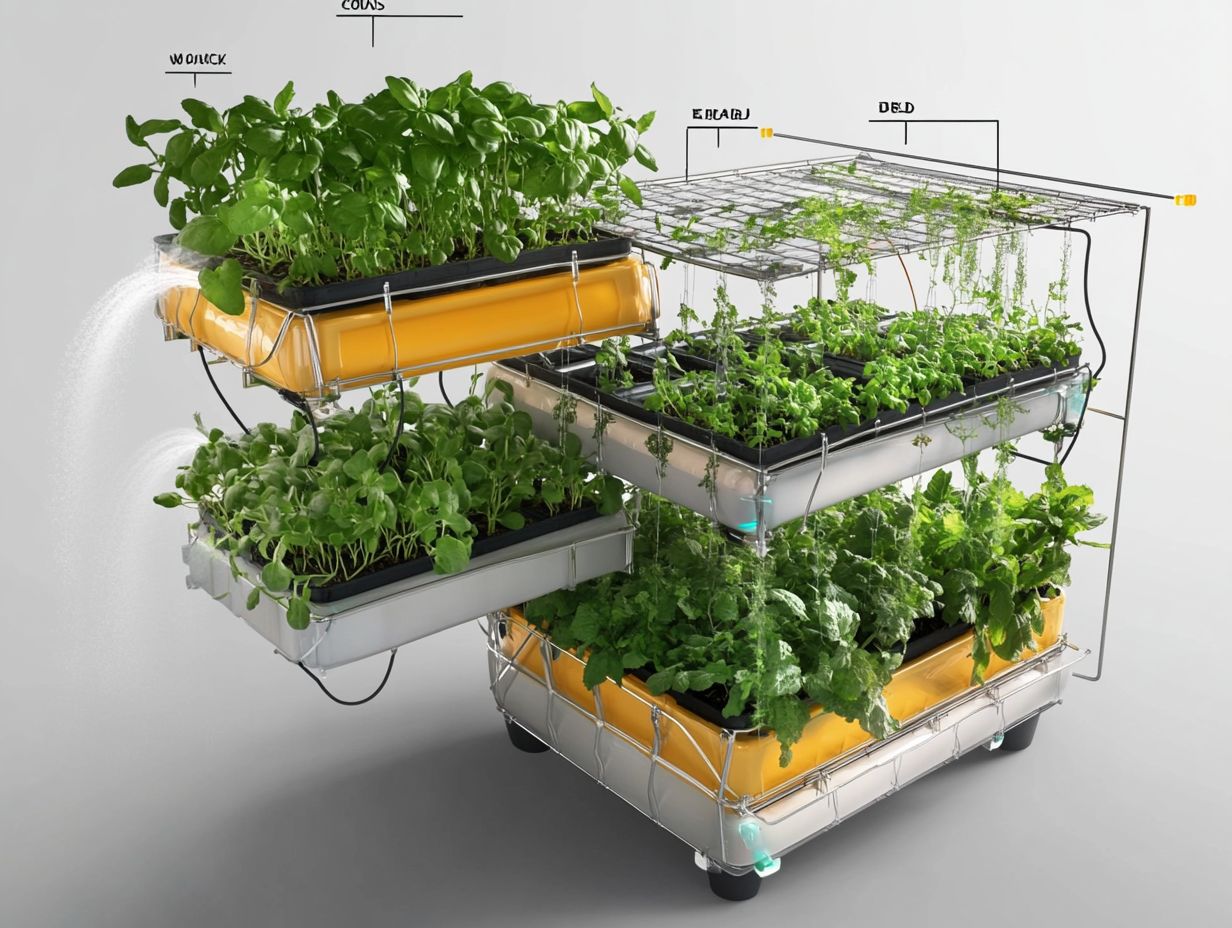
- Aeroponics and hydroponics are two methods of soilless gardening that differ in their use of growing medium, water and nutrient delivery, growth rate and yield, and cost and maintenance.
- Aeroponics has a faster growth rate and higher yield potential, while hydroponics is more cost-effective and low-maintenance.
- Both aeroponics and hydroponics have their own set of advantages and disadvantages, and the choice between them ultimately depends on your specific needs and preferences as a gardener.
Overview of Aeroponics and Hydroponics
Aeroponics and hydroponics embody the forefront of soilless farming, offering an innovative way to cultivate plants while significantly reducing environmental impact.
These advanced methods utilize controlled environments that optimize nutrient delivery and water usage, making them perfect for both commercial growers and home enthusiasts passionate about sustainable agriculture.
Say goodbye to pests and diseases by growing without soil! These techniques can also be used for urban agriculture, unlocking the potential to grow vegetables, herbs, and microgreens even in limited spaces or challenging climates.
Definitions and Basic Principles
Hydroponics is an advanced method of cultivating plants without the use of soil, utilizing water mixed with nutrients to deliver essential nutrients directly to the roots.
Aeroponics takes this innovation a step further by suspending plant roots in air and misting them with a nutrient solution.
Both systems represent cutting-edge approaches to cultivation, relying on controlled environments that dramatically enhance growth rates and yields.
Hydroponics encompasses various sub-systems, such as deep water culture and nutrient film technique, which facilitate efficient water and nutrient uptake. If you’re unfamiliar, deep water culture involves keeping plant roots submerged in a nutrient-rich solution, while nutrient film technique uses a thin film of water to nourish roots.
On the other hand, aeroponics employs high-pressure misting systems to ensure an even distribution of moisture, significantly reducing water consumption compared to traditional agriculture.
These methods not only minimize resource usage but also enable year-round production in urban and indoor settings, making them exceptionally suited for commercial operations and sustainable farming practices.
Key Differences between Aeroponics and Hydroponics
Understanding the key differences between aeroponics and hydroponics is vital for you as a grower selecting the ideal method for your agricultural needs.
These systems differ considerably in their growing mediums, water and nutrient delivery methods, and their overall effect on plant yields.
Grasping these distinctions will empower you to make an informed choice that aligns with your specific goals.
Don’t miss out on the chance to grow your own sustainable garden at home! Start your soilless gardening journey today!
Growing Medium
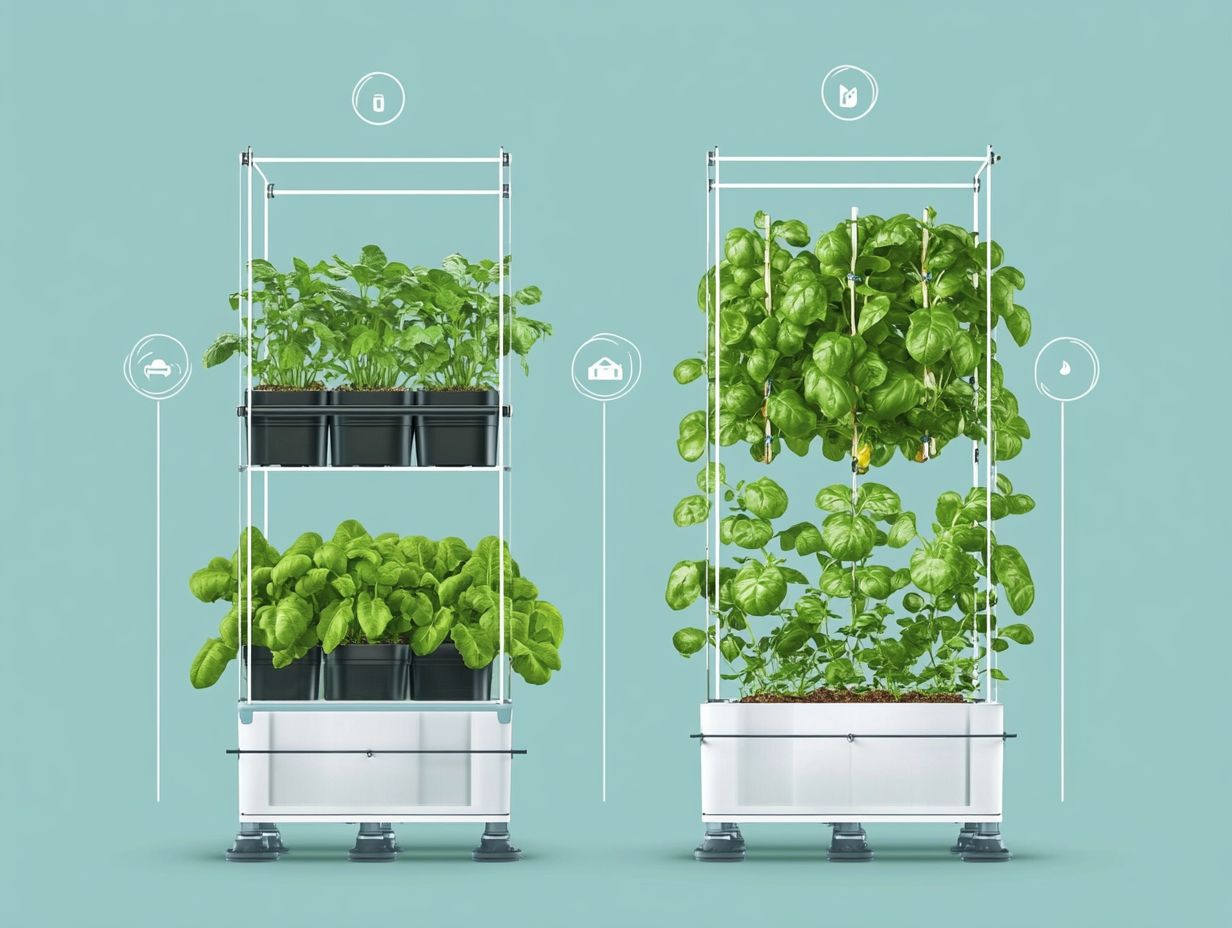
In hydroponics, you’ll find plants flourishing in inert mediums like coconut coir, rock wool, or perlite. Aeroponics takes it a step further by allowing roots to dangle freely in the air without any solid medium.
These mediums play distinct roles in plant growth. For example, coconut coir excels in water retention and aeration but may need a nutrient boost. Meanwhile, rock wool offers excellent structural support but can be a hassle to dispose of once it has served its purpose.
Aeroponics maximizes oxygen exposure to the roots, which can lead to faster growth and enhanced nutrient absorption. However, it requires meticulous environmental control to ward off potential issues like root rot.
By understanding these dynamics in both hydroponic and aeroponic systems, you can make informed decisions that significantly influence plant health and yield, all while embracing the revolutionary benefits of soil-less farming methods.
Water and Nutrient Delivery
The water and nutrient delivery systems in hydroponics and aeroponics present a fascinating contrast. Hydroponics typically employs methods such as drip systems and a thin film of nutrient-rich water, while aeroponics takes it up a notch with high-pressure aeroponics, a method that uses pressure to spray a fine mist of nutrients directly onto the plant roots.
In hydroponics, the drip systems meticulously dispense a steady stream of water mixed with nutrients right to the plant roots. This ensures your plants receive a consistent supply of hydration and essential elements.
Meanwhile, the thin film of nutrient-rich water flows continuously over the roots, optimizing both oxygenation and nutrient absorption.
Aeroponics utilizes a high-pressure system that atomizes the nutrient solution into a fine mist. This method enhances nutrient uptake while significantly reducing water usage. Each approach carries its own set of advantages and disadvantages regarding efficiency, effectiveness, and overall impact on plant growth. To better understand these methods, including the difference between hydroponics and soil, catering to various agricultural needs and aspirations.
Growth Rate and Yield
Aeroponics offers the promise of faster growth rates and higher yields compared to hydroponics! Research suggests that aeroponic systems can enhance growth rates by as much as 30% over traditional hydroponic methods. This advantage stems from the roots receiving a fine mist of nutrients and oxygen, which significantly reduces the risk of root diseases.
For instance, while hydroponics typically yields around 10-15% per cycle, aeroponics can achieve yields of 20-25% within the same timeframe. This difference is especially crucial for commercial growers focused on maximizing profits, as the increased productivity translates to a quicker return on investment.
On the other hand, if you’re a home grower, you might find the compact design of aeroponics appealing. It allows you to cultivate a greater variety of crops in limited spaces, even if the scale of yield enhancement isn’t as pronounced.
Cost and Maintenance
While you may find that the initial setup costs for aeroponics can be on the higher side due to advanced technology, the ongoing maintenance expenses might actually be lower than those associated with hydroponics, particularly for commercial growers focused on long-term sustainability.
Understanding this balance is key to making smart choices regarding the overall investment potential and return on investment for both methods. The upfront costs of aeroponic systems often encompass sophisticated pumps, sensors, and nutrient delivery mechanisms, but the efficiency in water and nutrient utilization can lead to considerable savings over time.
On the other hand, hydroponics might appear more accessible at first glance, yet it can rack up higher costs for nutrient solutions and electricity to power the pumps, which can significantly impact your operational budget.
These considerations are essential in your decision-making process, whether you’re launching a large-scale operation or tending to a small home garden, as you weigh long-term viability against immediate expenditures.
Advantages and Disadvantages of Aeroponics
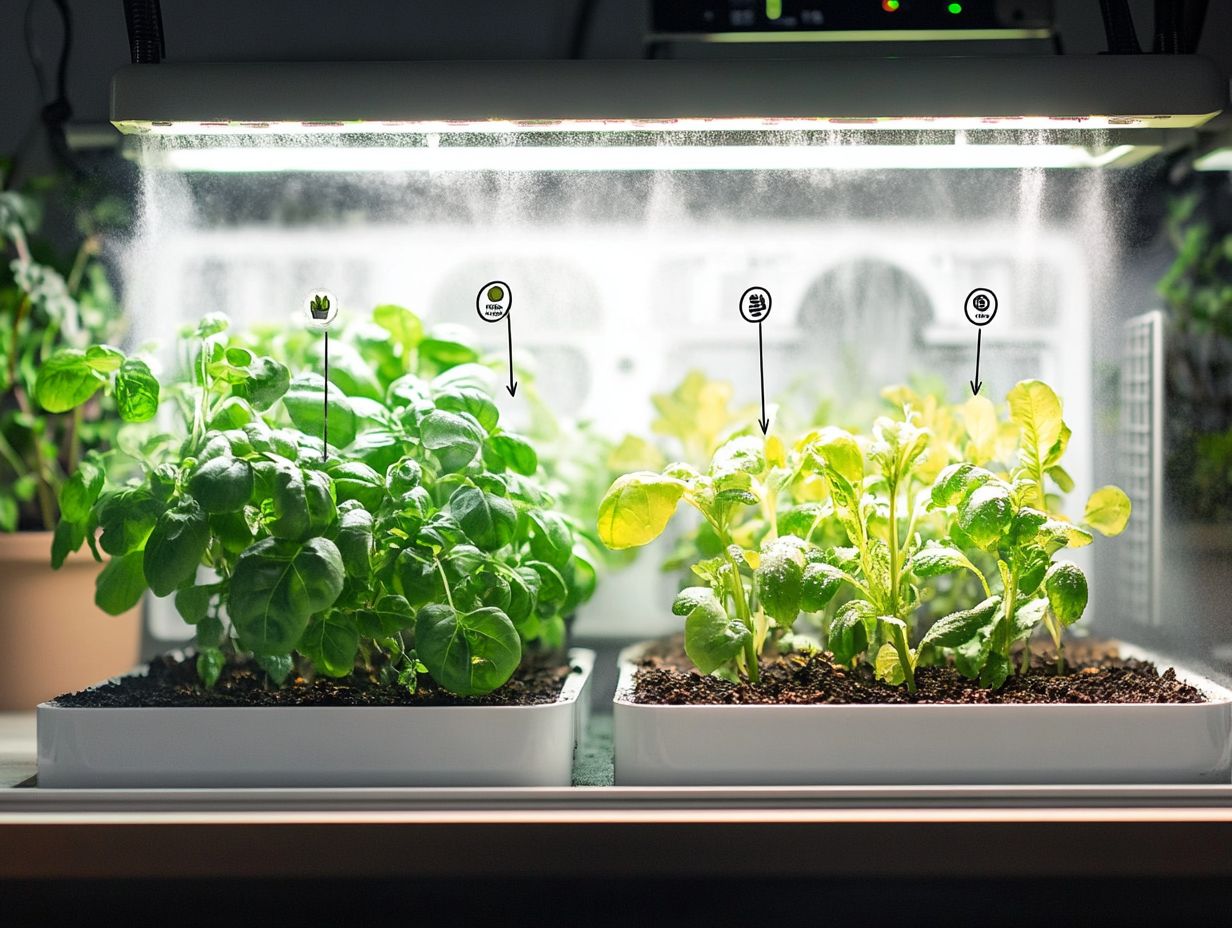
Aeroponics presents numerous advantages, such as accelerated growth rates and significantly reduced water usage. These factors make it an enticing choice for sustainable agriculture.
However, it also comes with its own set of challenges that you should consider as a grower.
Pros and Cons of Using Aeroponics
The advantages of using aeroponics are compelling: you can enjoy higher yields, reduced nutrient usage, and efficient water management.
It s important to consider these benefits alongside a few challenges that may arise. One standout benefit of aeroponics is its remarkable capacity to produce up to 30% more crops compared to traditional soil-based methods. This increase comes from the oxygen-rich environment created by the misting system. It significantly speeds up plant growth.
Since crops receive nutrients directly through the air, nutrient wastage is drastically reduced, leading to substantial cost savings over time.
That said, you should be mindful of the technology’s complexity, which can pose challenges. A solid understanding of the system’s mechanics is essential for troubleshooting issues, making it potentially intimidating for newcomers to the field.
Advantages and Disadvantages of Hydroponics
Hydroponics offers a wealth of advantages, including remarkable water efficiency and the ability to cultivate crops across a variety of climates. However, it s crucial to recognize that it comes with its own set of challenges that any prospective grower should carefully consider.
Pros and Cons of Using Hydroponics
The advantages of using hydroponics include precise nutrient delivery, consistent yields, and a significantly reduced environmental impact. However, it s essential to consider the disadvantages, such as reliance on technology and the risk of power outages during critical growth phases.
By managing nutrient solutions with care, you can minimize waste and maximize plant growth. This often results in faster harvest times compared to traditional soil methods. For instance, if you grow leafy greens in hydroponic systems, you can yield produce in half the time, giving you a quicker return on your investment.
Yet, this reliance on sophisticated technology comes with its own set of risks. A malfunction whether a pump failure or an unexpected power outage can jeopardize crop health and lead to potential losses.
While the initial setup costs might deter some farmers, the long-term savings on water and fertilizers cannot be ignored. Balancing these factors is crucial for anyone contemplating a shift to hydroponic farming.
Frequently Asked Questions
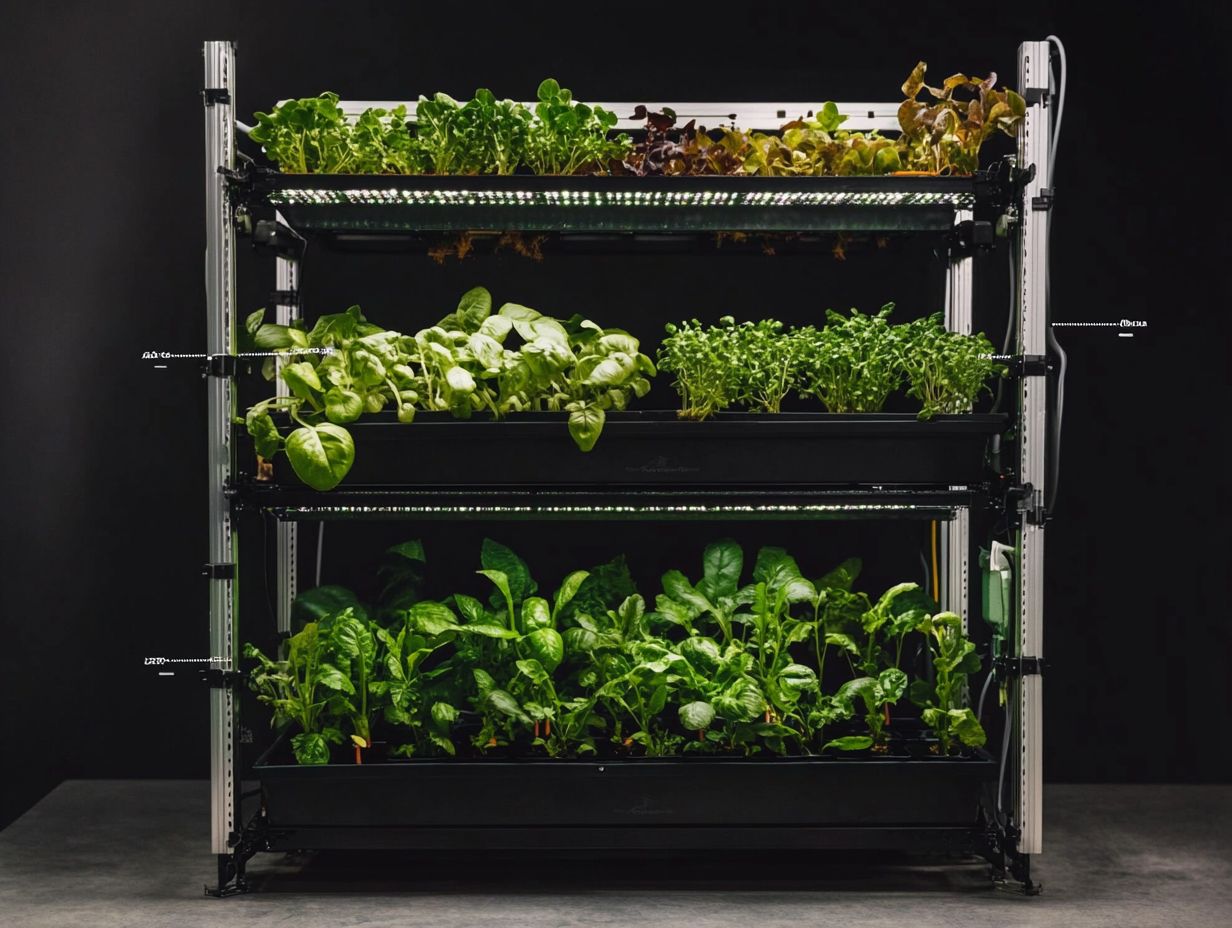
How do aeroponics and hydroponics differ in growing plants?
Both aeroponics and hydroponics are methods of growing plants without soil. They differ in how they provide nutrients and water to the plants. Aeroponics uses a misting system to deliver nutrients directly to the plant’s roots, while hydroponics uses a water-based solution.
Which method is more efficient in terms of water usage?
Aeroponics is more efficient in terms of water usage compared to hydroponics. The misting system in aeroponics allows for better absorption of nutrients, reducing the amount of water needed to grow plants.
Can both methods be used for commercial farming?
Yes, both aeroponics and hydroponics can be used for commercial farming. However, aeroponics is more commonly used in commercial settings due to its higher efficiency and lower water usage.
Does aeroponics require more maintenance than hydroponics?
No, aeroponics requires less maintenance compared to hydroponics. The misting system in aeroponics delivers nutrients directly to the plant’s roots, eliminating the need for regular monitoring and adjustment of nutrient levels.
Which method grows plants better?
Aeroponics and hydroponics both grow plants well. Aeroponics grows plants faster and produces higher yields!
Is there a big cost difference between aeroponics and hydroponics?
Aeroponics can cost more to set up because of the misting system. Yet, it can save money over time thanks to lower water and maintenance costs.

